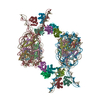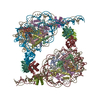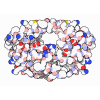+ データを開く
データを開く
- 基本情報
基本情報
| 登録情報 | データベース: PDB / ID: 9j8m | |||||||||||||||||||||||||||||||||
|---|---|---|---|---|---|---|---|---|---|---|---|---|---|---|---|---|---|---|---|---|---|---|---|---|---|---|---|---|---|---|---|---|---|---|
| タイトル | Cryo-EM structure of BAF-Lamin A/C IgF-nucleosome complex (High mobility complex) | |||||||||||||||||||||||||||||||||
 要素 要素 |
| |||||||||||||||||||||||||||||||||
 キーワード キーワード | NUCLEAR PROTEIN / Nucleosome / DNA binding proteins / Nuclear lamina | |||||||||||||||||||||||||||||||||
| 機能・相同性 |  機能・相同性情報 機能・相同性情報structural constituent of nuclear lamina / negative regulation of mesenchymal cell proliferation / negative regulation of protein ADP-ribosylation / establishment or maintenance of microtubule cytoskeleton polarity / Breakdown of the nuclear lamina / DNA double-strand break attachment to nuclear envelope / ventricular cardiac muscle cell development / Depolymerization of the Nuclear Lamina / nuclear envelope organization / Nuclear Envelope Breakdown ...structural constituent of nuclear lamina / negative regulation of mesenchymal cell proliferation / negative regulation of protein ADP-ribosylation / establishment or maintenance of microtubule cytoskeleton polarity / Breakdown of the nuclear lamina / DNA double-strand break attachment to nuclear envelope / ventricular cardiac muscle cell development / Depolymerization of the Nuclear Lamina / nuclear envelope organization / Nuclear Envelope Breakdown / nuclear pore localization / lamin filament / protein localization to nuclear envelope / mitotic nuclear membrane reassembly / XBP1(S) activates chaperone genes / nuclear lamina / Initiation of Nuclear Envelope (NE) Reformation / regulation of protein localization to nucleus / intermediate filament / Integration of viral DNA into host genomic DNA / Autointegration results in viral DNA circles / regulation of telomere maintenance / negative regulation of type I interferon production / negative regulation of cardiac muscle hypertrophy in response to stress / nuclear migration / negative regulation of viral genome replication / muscle organ development / negative regulation of cGAS/STING signaling pathway / 2-LTR circle formation / Deregulated CDK5 triggers multiple neurodegenerative pathways in Alzheimer's disease models / Vpr-mediated nuclear import of PICs / negative regulation of release of cytochrome c from mitochondria / Integration of provirus / APOBEC3G mediated resistance to HIV-1 infection / protein localization to nucleus / negative regulation of tumor necrosis factor-mediated signaling pathway / chromosome organization / negative regulation of megakaryocyte differentiation / protein localization to CENP-A containing chromatin / Chromatin modifying enzymes / Replacement of protamines by nucleosomes in the male pronucleus / CENP-A containing nucleosome / condensed chromosome / Packaging Of Telomere Ends / Recognition and association of DNA glycosylase with site containing an affected purine / Cleavage of the damaged purine / Deposition of new CENPA-containing nucleosomes at the centromere / Recognition and association of DNA glycosylase with site containing an affected pyrimidine / Cleavage of the damaged pyrimidine / telomere organization / Interleukin-7 signaling / RNA Polymerase I Promoter Opening / Inhibition of DNA recombination at telomere / negative regulation of innate immune response / regulation of cell migration / epigenetic regulation of gene expression / Meiotic synapsis / Assembly of the ORC complex at the origin of replication / SUMOylation of chromatin organization proteins / Regulation of endogenous retroelements by the Human Silencing Hub (HUSH) complex / DNA methylation / Condensation of Prophase Chromosomes / Chromatin modifications during the maternal to zygotic transition (MZT) / SIRT1 negatively regulates rRNA expression / HCMV Late Events / innate immune response in mucosa / ERCC6 (CSB) and EHMT2 (G9a) positively regulate rRNA expression / PRC2 methylates histones and DNA / negative regulation of extrinsic apoptotic signaling pathway / Regulation of endogenous retroelements by KRAB-ZFP proteins / Defective pyroptosis / HDACs deacetylate histones / Regulation of endogenous retroelements by Piwi-interacting RNAs (piRNAs) / Nonhomologous End-Joining (NHEJ) / RNA Polymerase I Promoter Escape / lipopolysaccharide binding / Transcriptional regulation by small RNAs / Formation of the beta-catenin:TCF transactivating complex / Activated PKN1 stimulates transcription of AR (androgen receptor) regulated genes KLK2 and KLK3 / RUNX1 regulates genes involved in megakaryocyte differentiation and platelet function / HDMs demethylate histones / G2/M DNA damage checkpoint / DNA integration / NoRC negatively regulates rRNA expression / regulation of protein stability / B-WICH complex positively regulates rRNA expression / DNA Damage/Telomere Stress Induced Senescence / PKMTs methylate histone lysines / structural constituent of cytoskeleton / Meiotic recombination / Pre-NOTCH Transcription and Translation / response to virus / Metalloprotease DUBs / RMTs methylate histone arginines / Activation of anterior HOX genes in hindbrain development during early embryogenesis / nuclear matrix / Transcriptional regulation of granulopoiesis / protein import into nucleus / HCMV Early Events / antimicrobial humoral immune response mediated by antimicrobial peptide 類似検索 - 分子機能 | |||||||||||||||||||||||||||||||||
| 生物種 |  Homo sapiens (ヒト) Homo sapiens (ヒト)synthetic construct (人工物) | |||||||||||||||||||||||||||||||||
| 手法 | 電子顕微鏡法 / 単粒子再構成法 / クライオ電子顕微鏡法 / 解像度: 3.82 Å | |||||||||||||||||||||||||||||||||
 データ登録者 データ登録者 | Horikoshi, N. / Miyake, R. / Sogawa-Fujiwara, C. / Ogasawara, M. / Takizawa, Y. / Kurumizaka, H. | |||||||||||||||||||||||||||||||||
| 資金援助 |  日本, 10件 日本, 10件
| |||||||||||||||||||||||||||||||||
 引用 引用 |  ジャーナル: Nat Commun / 年: 2025 ジャーナル: Nat Commun / 年: 2025タイトル: Cryo-EM structures of the BAF-Lamin A/C complex bound to nucleosomes. 著者: Naoki Horikoshi / Ryosuke Miyake / Chizuru Sogawa-Fujiwara / Mitsuo Ogasawara / Yoshimasa Takizawa / Hitoshi Kurumizaka /  要旨: Barrier-to-autointegration factor (BAF) associates with mitotic chromosomes and promotes nuclear envelope assembly by recruiting proteins, such as Lamins, required for the reconstruction of the ...Barrier-to-autointegration factor (BAF) associates with mitotic chromosomes and promotes nuclear envelope assembly by recruiting proteins, such as Lamins, required for the reconstruction of the nuclear envelope and lamina. BAF also mediates chromatin anchoring to the nuclear lamina via Lamin A/C. However, the mechanism by which BAF and Lamin A/C bind chromatin and affect the chromatin organization remains elusive. Here we report the cryo-electron microscopy structures of BAF-Lamin A/C-nucleosome complexes. We find that the BAF dimer complexed with the Lamin A/C IgF domain occupies the nucleosomal dyad position, forming a tripartite nucleosomal DNA binding structure. We also show that the Lamin A/C Lys486 and His506 residues, which are reportedly mutated in lipodystrophy patients, directly contact the DNA at the nucleosomal dyad. Excess BAF-Lamin A/C complexes symmetrically bind other nucleosomal DNA sites and connect two BAF-Lamin A/C-nucleosome complexes. Although the linker histone H1 competes with BAF-Lamin A/C binding at the nucleosomal dyad region, the two BAF-Lamin A/C molecules still bridge two nucleosomes. These findings provide insights into the mechanism by which BAF, Lamin A/C, and/or histone H1 bind nucleosomes and influence chromatin organization within the nucleus. | |||||||||||||||||||||||||||||||||
| 履歴 |
|
- 構造の表示
構造の表示
| 構造ビューア | 分子:  Molmil Molmil Jmol/JSmol Jmol/JSmol |
|---|
- ダウンロードとリンク
ダウンロードとリンク
- ダウンロード
ダウンロード
| PDBx/mmCIF形式 |  9j8m.cif.gz 9j8m.cif.gz | 392.4 KB | 表示 |  PDBx/mmCIF形式 PDBx/mmCIF形式 |
|---|---|---|---|---|
| PDB形式 |  pdb9j8m.ent.gz pdb9j8m.ent.gz | 296.6 KB | 表示 |  PDB形式 PDB形式 |
| PDBx/mmJSON形式 |  9j8m.json.gz 9j8m.json.gz | ツリー表示 |  PDBx/mmJSON形式 PDBx/mmJSON形式 | |
| その他 |  その他のダウンロード その他のダウンロード |
-検証レポート
| 文書・要旨 |  9j8m_validation.pdf.gz 9j8m_validation.pdf.gz | 1.3 MB | 表示 |  wwPDB検証レポート wwPDB検証レポート |
|---|---|---|---|---|
| 文書・詳細版 |  9j8m_full_validation.pdf.gz 9j8m_full_validation.pdf.gz | 1.3 MB | 表示 | |
| XML形式データ |  9j8m_validation.xml.gz 9j8m_validation.xml.gz | 46.6 KB | 表示 | |
| CIF形式データ |  9j8m_validation.cif.gz 9j8m_validation.cif.gz | 74 KB | 表示 | |
| アーカイブディレクトリ |  https://data.pdbj.org/pub/pdb/validation_reports/j8/9j8m https://data.pdbj.org/pub/pdb/validation_reports/j8/9j8m ftp://data.pdbj.org/pub/pdb/validation_reports/j8/9j8m ftp://data.pdbj.org/pub/pdb/validation_reports/j8/9j8m | HTTPS FTP |
-関連構造データ
| 関連構造データ |  61231MC  9j8nC  9j8oC M: このデータのモデリングに利用したマップデータ C: 同じ文献を引用 ( |
|---|---|
| 類似構造データ | 類似検索 - 機能・相同性  F&H 検索 F&H 検索 |
- リンク
リンク
- 集合体
集合体
| 登録構造単位 | 
|
|---|---|
| 1 |
|
- 要素
要素
-タンパク質 , 6種, 11分子 AEBFCGDHKLM
| #1: タンパク質 | 分子量: 15719.445 Da / 分子数: 2 / 由来タイプ: 組換発現 / 由来: (組換発現)  Homo sapiens (ヒト) Homo sapiens (ヒト)遺伝子: H3C1, H3FA, HIST1H3A, H3C2, H3FL, HIST1H3B, H3C3, H3FC HIST1H3C, H3C4, H3FB, HIST1H3D, H3C6, H3FD, HIST1H3E, H3C7, H3FI, HIST1H3F, H3C8, H3FH, HIST1H3G, H3C10, H3FK, HIST1H3H, H3C11, H3FF, ...遺伝子: H3C1, H3FA, HIST1H3A, H3C2, H3FL, HIST1H3B, H3C3, H3FC HIST1H3C, H3C4, H3FB, HIST1H3D, H3C6, H3FD, HIST1H3E, H3C7, H3FI, HIST1H3F, H3C8, H3FH, HIST1H3G, H3C10, H3FK, HIST1H3H, H3C11, H3FF, HIST1H3I, H3C12, H3FJ, HIST1H3J 発現宿主:  #2: タンパク質 | 分子量: 11676.703 Da / 分子数: 2 / 由来タイプ: 組換発現 / 由来: (組換発現)  Homo sapiens (ヒト) / 遺伝子: H4C1 / 発現宿主: Homo sapiens (ヒト) / 遺伝子: H4C1 / 発現宿主:  #3: タンパク質 | 分子量: 14447.825 Da / 分子数: 2 / 由来タイプ: 組換発現 / 由来: (組換発現)  Homo sapiens (ヒト) / 遺伝子: H2AC4, H2AFM, HIST1H2AB, H2AC8, H2AFA, HIST1H2AE / 発現宿主: Homo sapiens (ヒト) / 遺伝子: H2AC4, H2AFM, HIST1H2AB, H2AC8, H2AFA, HIST1H2AE / 発現宿主:  #4: タンパク質 | 分子量: 14217.516 Da / 分子数: 2 / 由来タイプ: 組換発現 / 由来: (組換発現)  Homo sapiens (ヒト) / 遺伝子: H2BC11, H2BFR, HIST1H2BJ / 発現宿主: Homo sapiens (ヒト) / 遺伝子: H2BC11, H2BFR, HIST1H2BJ / 発現宿主:  #7: タンパク質 | 分子量: 10487.059 Da / 分子数: 2 / 由来タイプ: 組換発現 / 由来: (組換発現)  Homo sapiens (ヒト) / 遺伝子: BANF1, BAF, BCRG1 / 発現宿主: Homo sapiens (ヒト) / 遺伝子: BANF1, BAF, BCRG1 / 発現宿主:  #8: タンパク質 | | 分子量: 17551.369 Da / 分子数: 1 / Fragment: Ig-fold domain / 由来タイプ: 組換発現 / 由来: (組換発現)  Homo sapiens (ヒト) / 遺伝子: LMNA, LMN1 / 発現宿主: Homo sapiens (ヒト) / 遺伝子: LMNA, LMN1 / 発現宿主:  |
|---|
-DNA鎖 , 2種, 2分子 IJ
| #5: DNA鎖 | 分子量: 59351.793 Da / 分子数: 1 / 由来タイプ: 組換発現 / 由来: (組換発現) synthetic construct (人工物) / 発現宿主:  |
|---|---|
| #6: DNA鎖 | 分子量: 59823.086 Da / 分子数: 1 / 由来タイプ: 組換発現 / 由来: (組換発現) synthetic construct (人工物) / 発現宿主:  |
-詳細
| Has protein modification | N |
|---|
-実験情報
-実験
| 実験 | 手法: 電子顕微鏡法 |
|---|---|
| EM実験 | 試料の集合状態: PARTICLE / 3次元再構成法: 単粒子再構成法 |
- 試料調製
試料調製
| 構成要素 | 名称: High mobility complex containing BAF, Lamin A/C IgF, and nucleosome タイプ: COMPLEX / Entity ID: all / 由来: RECOMBINANT |
|---|---|
| 分子量 | 値: 0.27 MDa / 実験値: NO |
| 由来(天然) | 生物種:  Homo sapiens (ヒト) Homo sapiens (ヒト) |
| 由来(組換発現) | 生物種:  |
| 緩衝液 | pH: 7.5 |
| 試料 | 包埋: NO / シャドウイング: NO / 染色: NO / 凍結: YES |
| 急速凍結 | 凍結剤: ETHANE |
- 電子顕微鏡撮影
電子顕微鏡撮影
| 実験機器 |  モデル: Titan Krios / 画像提供: FEI Company |
|---|---|
| 顕微鏡 | モデル: FEI TITAN KRIOS |
| 電子銃 | 電子線源:  FIELD EMISSION GUN / 加速電圧: 300 kV / 照射モード: FLOOD BEAM FIELD EMISSION GUN / 加速電圧: 300 kV / 照射モード: FLOOD BEAM |
| 電子レンズ | モード: BRIGHT FIELD / 最大 デフォーカス(公称値): 2500 nm / 最小 デフォーカス(公称値): 1000 nm |
| 撮影 | 電子線照射量: 60.4 e/Å2 フィルム・検出器のモデル: GATAN K3 BIOQUANTUM (6k x 4k) |
- 解析
解析
| EMソフトウェア | 名称: PHENIX / カテゴリ: モデル精密化 | ||||||||||||||||||||||||
|---|---|---|---|---|---|---|---|---|---|---|---|---|---|---|---|---|---|---|---|---|---|---|---|---|---|
| CTF補正 | タイプ: PHASE FLIPPING AND AMPLITUDE CORRECTION | ||||||||||||||||||||||||
| 3次元再構成 | 解像度: 3.82 Å / 解像度の算出法: FSC 0.143 CUT-OFF / 粒子像の数: 18999 / 対称性のタイプ: POINT | ||||||||||||||||||||||||
| 拘束条件 |
|
 ムービー
ムービー コントローラー
コントローラー





 PDBj
PDBj
















































